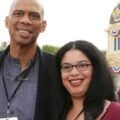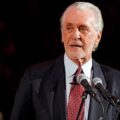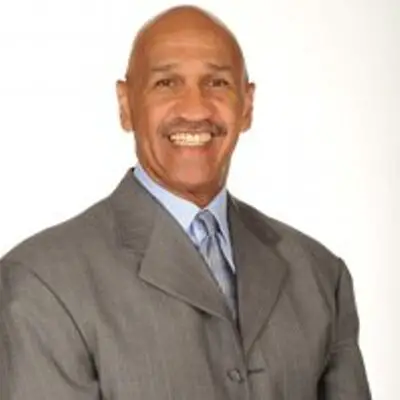Kareem Abdul Jabbar Biography
Kareem Abdul-Jabbar is an American former professional basketball player who played 20 seasons in the National Basketball Association (NBA) for the Milwaukee Bucks and the Los Angeles Lakers. During his career as a center, Abdul-Jabbar was a record six-time NBA Most Valuable Player (MVP), a record 19-time NBA All-Star, a 15-time All-NBA selection, and an 11-time NBA All-Defensive Team member.
Kareem Abdul Jabbar Age|Birthday
Kareem was born on April 16, 1947, in New York City, New York, U.S.A. He is 72 years old as of 2019. He celebrates his birthday on April 16 every year. His full names are Ferdinand Lewis Alcindor Jr.
Kareem Abdul Jabbar Family
Kareem was born in New York City to Cora Lillian, a department store price checker, and Ferdinand Lewis Alcindor Sr., a transit police officer, and jazz musician. He grew up in the Dyckman Street projects in the Inwood neighborhood of Upper Manhattan. Alcindor was unusually large and tall from a young age. At birth, he weighed 12 lb 11 oz (5.75 kg) and was 22 1⁄2 inches (57 cm) long,
Kareem Abdul Jabbar Wife
In 1971, he married the love of his life Habiba Abdul-Jabbar and parted later in 1978.
Kareem Abdul Jabbar Children|Kids
He is a father of five children; three sons and two daughters. The children are: Kareem Abdul-Jabbar Jr., Habiba Abdul-Jabbar, Sultana Abdul-Jabbar, Amir Abdul-Jabbar, and Adam Abdul-Jabbar
Kareem Abdul Jabbar Net Worth
Kareem Abdul-Jabbar is an American former professional basketball player who has an estimated net worth of $20 million dollars.
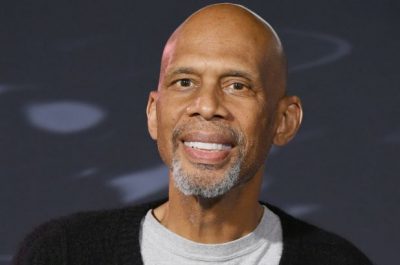
Kareem Abdul Jabbar Milwaukee Bucks
Alcindor’s presence enabled the 1969–70 Bucks to claim second place in the NBA’s Eastern Division with a 56–26 record (improved from 27–55 the previous year). Alcindor was an instant star, ranking second in the league in scoring (28.8 ppg) and third in rebounding (14.5 rpg), for which he was awarded the title of NBA Rookie of the Year.
Until Jayson Tatum in 2018, Alcindor would be the only rookie to record 10 or more games of 20+ points scored during the playoffs. The next season, the Bucks acquired All-Star guard Oscar Robertson. Milwaukee went on to record the best record in the league with 66 victories in the 1970–71 season, including a then-record 20 straight wins. Alcindor was awarded his first of six NBA Most Valuable Player Awards, along with his first scoring title (31.7 ppg).
He also led the league in total points, with 2,596. In the playoffs, the Bucks went 12–2 (including a four-game sweep of the Baltimore Bullets in the NBA Finals), and won the championship, while Alcindor was named Finals MVP. On May 1, 1971, the day after the Bucks won the NBA championship, he adopted the Muslim name Kareem Abdul-Jabbar (Arabic: كريم عبد الجبار, Karīm Abd al-Jabbār), its translation roughly “the noble one, servant of the Almighty [i.e., servant of Allah]”.
He had converted to Islam while at UCLA. Abdul-Jabbar remained a dominant force for the Bucks. The following year, he repeated as scoring champion with (34.8 ppg and 2,822 total points) and was named NBA Most Valuable Player. He helped the Bucks to repeat as division leaders for four straight years. In 1974, Abdul-Jabbar won his third MVP Award in five years and was among the top five NBA players in scoring (27.0 ppg, third), rebounding (14.5 rpg, fourth), blocked shots (283, second), and field goal percentage (.539, second).
Abdul-Jabbar remained relatively injury-free throughout his NBA career, but he twice broke one of his hands. The first incident occurred during a pre-season game in 1974, when he was bumped hard and got his eye scratched; this angered him enough to punch the basket support stanchion. He returned after missing the first 16 games of the season and started to wear protective goggles.
In the second incident, he broke his hand during the opening game of the 1977–78 season. Two minutes into the game, Abdul-Jabbar punched Milwaukee’s Kent Benson in retaliation for an overly aggressive elbow; the punch broke Benson’s jaw. As a result of the injury to his hand, Abdul-Jabbar was out for two months, and it was unnecessary for the NBA to suspend him. Although Abdul-Jabbar always spoke well of Milwaukee and its fans, he said that being in the Midwest did not fit his cultural needs. In October 1974, he requested a trade to either the New York Knicks or Los Angeles.
Kareem Abdul Jabbar Lakers
In 1975, the Lakers acquired Abdul-Jabbar and reserve center Walt Wesley from the Bucks for center Elmore Smith, guard Brian Winters, and rookie “blue chippers” Dave Meyers and Junior Bridgeman. In the 1975–76 season, his first with the Lakers, he had a dominating season, averaging 27.7 points per game and leading the league in rebounding, blocked shots, and minutes played. His 1,111 defensive rebounds remain the NBA single-season record (defensive rebounds were not recorded prior to the 1973–74 season).
He earned his fourth MVP award but missed the post-season for the second straight year. Once he joined the Lakers, Abdul-Jabbar began wearing his trademark goggles (he briefly ditched them in the 1979–80 season). Years of battling under NBA backboards, and being hit and scratched in the face in the process, had taken their toll on his eyes and he developed corneal erosion syndrome, where the eyes begin to dry out easily and cease to produce moisture.
He missed one game in the 1986–87 season when his eyes dried out and swelled. In the 1976–77 season, Abdul-Jabbar had another strong performance. He led the league in field goal percentage, finished second in rebounds and blocked shots, and third in points per game. He helped lead the Lakers to the best record in the NBA, and he won his record-tying fifth MVP award. In the playoffs, the Lakers beat the Golden State Warriors in the Western Conference semi-finals, setting up a confrontation with the Portland Trail Blazers.
The result was a memorable matchup, pitting Abdul-Jabbar against a young, injury-free Bill Walton. Although Abdul-Jabbar dominated the series statistically, Walton and the Trail Blazers (who were experiencing their first-ever run in the playoffs) swept the Lakers, behind Walton’s skillful passing and leadership. Abdul-Jabbar’s play remained strong during the next two seasons, being named to the All-NBA Second Team twice, the All-Defense First Team once, and the All-Defense Second Team once.
The Lakers, however, continued to be stymied in the playoffs, being eliminated by the Seattle SuperSonics in both 1978 and 1979. In 1979, the Lakers acquired first overall draft pick, Magic Johnson. The trade and draft paved the way for a Laker dynasty as they went on to become the most dominant team of the 1980s, appearing in the finals eight times and winning five NBA championships. Individually, while Abdul-Jabbar was not the dominant center he had been in the 1970s, he experienced a number of highlight moments.
Among them were his record sixth MVP award in 1980, four more All-NBA First Team designations, two more All-Defense First Team designations, the 1985 Finals MVP, and on April 5, 1984, breaking Wilt Chamberlain’s record for most career points. Later in his career, he bulked up to about 265 pounds (120 kg), to be able to withstand the strain of playing the highly physical center position into his early 40s. While in Los Angeles, Abdul-Jabbar started doing yoga in 1976 to improve his flexibility and was notable for his physical fitness regimen.
He says, “There is no way I could have played as long as I did without yoga.” In 1983, Abdul-Jabbar’s house burned down. Many of his belongings, including his beloved jazz LP collection of about 3,000 albums, were destroyed. Many Lakers fans sent and brought him albums, which he found uplifting. On June 28, 1989, Abdul-Jabbar was 42 years old when he announced that he would retire at the end of the season after 20 years in the NBA.
On his “retirement tour” he received standing ovations at games, home and away and gifts ranging from a yacht that said “Captain Skyhook” to framed jerseys from his basketball career to an Afghan rug. In his biography My Life, Magic Johnson recalls that many Lakers and Celtics legends participated in Abdul-Jabbar’s farewell game. Every player wore Abdul-Jabbar’s trademark goggles and had to try a skyhook at least once, which led to comic results.
The Lakers made the NBA Finals in each of Abdul-Jabbar’s final three seasons, defeating Boston in 1987, and Detroit in 1988. The Lakers lost to the Pistons in a four-game sweep in his final season. At the time of his retirement, Abdul-Jabbar held the record for most games played by a single player in the NBA; this would later be broken by Robert Parish. He also was the all-time record holder for most points (38,387), most field goals made (15,837), and most minutes played (57,446).
Kareem Abdul Jabbar NBA
Alcindor began his record-breaking basketball accomplishments when he was in high school, where he led coach Jack Donahue’s Power Memorial Academy team to three straight New York City Catholic championships, a 71-game winning streak, and a 79–2 overall record. This earned him a nickname “The tower from Power”. During his career as a center, Abdul-Jabbar was a record six-time NBA Most Valuable Player (MVP), a record 19-time NBA All-Star, a 15-time All-NBA selection, and an 11-time NBA All-Defensive Team member.
A member of six NBA championship teams as a player and two more as an assistant coach, Abdul-Jabbar twice was voted NBA Finals MVP. In 1996, he was honored as one of the 50 Greatest Players in NBA History. NBA coach Pat Riley and players Isiah Thomas and Julius Erving have called him the greatest basketball player of all time.
After winning 71 consecutive basketball games on his high school team in New York City, Alcindor was recruited by Jerry Norman, the assistant coach of UCLA, where he played for coach John Wooden on three consecutive national championship teams and was a record three-time MVP of the NCAA Tournament. Drafted with the first overall pick by the one-season-old Bucks franchise in the 1969 NBA draft, Alcindor spent six seasons in Milwaukee.
After leading the Bucks to its first NBA championship at age 24 in 1971, he took the Muslim name, Kareem Abdul-Jabbar. Using his trademark “skyhook” shot, he established himself as one of the league’s top scorers. In 1975, he was traded to the Lakers, with whom he played the final 14 seasons of his career and won five additional NBA championships. Abdul-Jabbar’s contributions were a key component in the “Showtime” era of Lakers basketball.
Over his 20-year NBA career, his teams succeeded in making the playoffs 18 times and got past the first round 14 times; his teams reached the NBA Finals on 10 occasions. At the time of his retirement at age 42 in 1989, Abdul-Jabbar was the NBA’s all-time leader in points scored (38,387), games played (1,560), minutes played (57,446), field goals made (15,837), field goal attempts (28,307), blocked shots (3,189), defensive rebounds (9,394), career wins (1,074), and personal fouls (4,657).
He remains the all-time leader in points scored, field goals made, and career wins. He is ranked third all-time in both rebounds and blocked shots. In 2007, ESPN voted him the greatest center of all time, in 2008, they named him the “greatest player in college basketball history”, and in 2016, they named him the second-best player in NBA history (behind Michael Jordan). Abdul-Jabbar has also been an actor, a basketball coach, and a best-selling author. In 2012, he was selected by Secretary of State Hillary Clinton to be a U.S. global cultural ambassador. In 2016, President Barack Obama awarded him the Presidential Medal of Freedom.
Kareem Abdul Jabbar UCLA
Alcindor played on the UCLA freshman team in 1966 only because the “freshman rule” was in effect, but his prowess was already well known.[24] He received national coverage when he made his varsity debut in 1967: Sports Illustrated described him as “The New Superstar.” From 1967 to 1969, he played on the varsity under head coach John Wooden.
He was the main contributor to the team’s three-year record of 88 wins and only two losses: one to the University of Houston in which Alcindor had an eye injury, and the other to crosstown rival USC who played a “stall game” (i.e., there was no shot clock in those days, so a team could hold the ball as long as it wanted before attempting to score). In his first game, Alcindor scored 56 points, which set a UCLA single-game record.
Kareem Abdul Jabbar Teams
At the beginning of his career, he played for UCLA back in 1966. He was the main contributor to the team leading it to a three-year record of 88 wins and only two losses of which he was not in the game. These wins were one of the reasons for his great success in the world of basketball and soon enough teams began looking for his presence in their team. He began playing professionally in 1969, playing for Milwaukee Bucks as the center mark.
He had previously been approached by the Harlem Globetrotters but he declined their $1 million offer and joined the Bucks. During their first time match with Kareem in their team, they won hence it came as an opening breakthrough for Bucks. In 1974 he played his last march before joining the Los Angeles Lakers team in 1975. He played for them for 14 years and left the team in 1989.
Kareem Abdul Jabbar Religion
During the summer of 1968, Alcindor took the shahada twice and converted to Sunni Islam, though he did not begin publicly using his Arabic name until 1971. He boycotted the 1968 Summer Olympics by deciding not to try out for the United States Men’s Olympic Basketball team. This action was in protest against the unequal treatment of African-Americans in the United States.
He was one of only four players who started on three NCAA championship teams; the others all played for Wooden at UCLA: Henry Bibby, Curtis Rowe, and Lynn Shackelford. In sharp contrast to what goes on today, Alcindor did not declare early for the NBA draft. He completed his studies and earned a Bachelor of Arts with a major in history in 1969. In his free time, he practiced martial arts. He studied Jeet Kune Do under Bruce Lee.
Kareem Abdul Jabbar Skyhook
Abdul-Jabbar was well known for his trademark “skyhook”, a hook shot in which he bent his entire body (rather than just the arm) like a straw in one fluid motion to raise the ball and then release it at the highest point of his arm’s arching motion. Combined with his long arms and great height 7 ft 2 in (2.18 m) the skyhook was difficult for a defender to block without committing a goaltending violation.
It was a reliable and feared offensive weapon and contributed to his high lifetime field goal percentage of 0.559. He was adept at shooting the skyhook with either hand, which made him even more difficult to defend against, though as a right-handed player, he was stronger shooting the skyhook with his right hand than he was with his left. According to Abdul-Jabbar, he learned the move in fifth grade after practicing with the Mikan Drill and soon learned to value it, as it was “the only shot I could use that didn’t get smashed back in my face”.
Kareem Abdul Jabbar Record
Abdul-Jabbar is the NBA’s all-time leading scorer with 38,387 points and won a league-record six MVP awards. He earned six championship rings, two Finals MVP awards, fifteen NBA First or Second Teams, a record nineteen NBA All-Star call-ups and averaging 24.6 points, 11.2 rebounds, 3.6 assists and 2.6 blocks per game.
Kareem Abdul Jabbar Retirement
He retired in 1989 is an accomplished player with lots of success in his career.
Kareem Abdul Jabbar Championships
He has been in many championship leagues. He has also been placed on the Hall of Fame basketball center. So far Kareem Abdul-Jabbar is the NBA’s all-time leading scorer. He won six NBA titles, five with the Los Angeles Lakers, over 20 years.
Kareem Abdul Jabbar Illness
Kareem Abdul-Jabbar, shocked the world sports when he announced that he had cancer. In an effort to help people understand his disease, he made a public disclosure a year after being diagnosed with Philadelphia chromosome-positive chronic myeloid leukemia (Ph+ CML).
Ph+ CML is a slowly progressing type of blood cancer that’s characterized by an abnormality known as the Philadelphia chromosome, which produces a protein called BCR-ABL. BCR-ABL and it’s been identified as the sole cause and driver of CML. “Having lost one of his closest friends to a different, highly aggressive form of leukemia, he knew how serious the diagnosis was,” “My own life expectancy became a question mark.”
Kareem Abdul Jabbar Islam
Conversion to Islam and the 1968 Olympic boycott
During the summer of 1968, Alcindor took the shahada twice and converted to Sunni Islam, though he did not begin publicly using his Arabic name until 1971. He boycotted the 1968 Summer Olympics by deciding not to try out for the United States Men’s Olympic Basketball team. This action was in protest against the unequal treatment of African-Americans in the United States.
He was one of only four players who started on three NCAA championship teams; the others all played for Wooden at UCLA: Henry Bibby, Curtis Rowe, and Lynn Shackelford. In sharp contrast to what goes on today, Alcindor did not declare early for the NBA draft. He completed his studies and earned a Bachelor of Arts with a major in history in 1969. In his free time, he practiced martial arts. He studied Jeet Kune Do under Bruce Lee.
Kareem Abdul Jabbar Game of the Century
On January 20, 1968, Alcindor and the UCLA Bruins faced coach Guy Lewis’s Houston Cougars in the first-ever nationally televised regular-season college basketball game, with 52,693 in attendance at the Astrodome. Cougar forward Elvin Hayes scored 39 points and had 15 rebounds, while Alcindor, who suffered from a scratch on his left cornea, was held to just 15 points as Houston won 71–69.
The Bruins’ 47-game winning streak ended in what has been called the “Game of the Century”. Hayes and Alcindor had a rematch in the semi-finals of the NCAA Tournament, where UCLA, with a healthy Alcindor, defeated Houston 101–69 en route to the national championship.
UCLA limited Hayes, who was averaging 37.7 points per game, to only ten points. Wooden credited his assistant, Jerry Norman, for devising the diamond-and-one defense that contained Hayes. Sports Illustrated ran a cover story on the game and used the headline: “Lew’s Revenge: The Rout of Houston.”
Kareem Abdul Jabbar Awards
- NBA Most Valuable Player Award 1980, 1977, 1976, …
- NBA Finals Most Valuable Player Award 1985, 1971
- All-NBA Team 1986, 1984, 1981, …
- NBA Rookie of the Year Award 1970
- NBA All-Defensive Team
1981, 1980, 1979, … - NBA All-Rookie Team 1970
- Naismith Men’s College Player of the Year 1969
- Presidential Medal of Freedom 2016
- Sports Illustrated Sportsperson of the Year 1985
- NAACP Image Award for Outstanding Literary Work – Children’s 2013 · What Color Is My World?: The Lost History of African-American Inventors
Kareem Abdul Jabbar Jersey|Statue
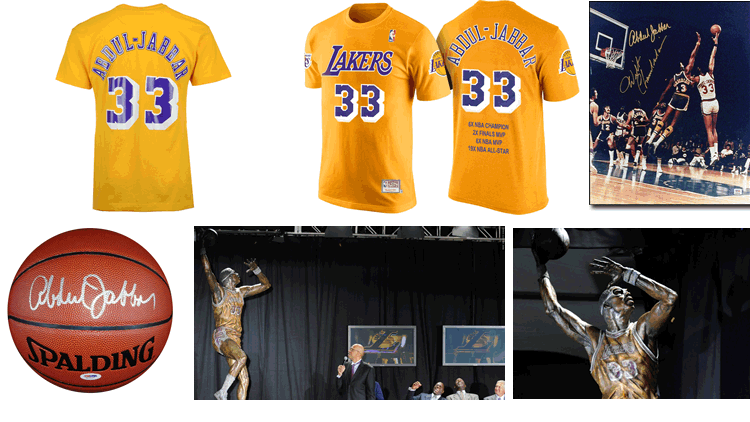
Kareem Abdul Jabbar Quotes
- One man can be a crucial ingredient on a team, but one man cannot make a team.
- You can’t win unless you learn how to lose.
- You have to be able to center yourself, to let all of your emotions go… Don’t ever forget that you play with your soul as well as your body.
- When I was a kid, no one would believe anything positive that you could say about black people. That’s a terrible burden.
- I think that the good and the great are only separated by the willingness to sacrifice.
- I try to do the right thing at the right time. They may just be little things, but usually, they make the difference between winning and losing.
- I can do something else besides stuff a ball through a hoop. My biggest resource is my mind.
- I tell kids to pursue their basketball dreams, but I tell them to not let that be their only dream.
- I’m not comfortable being preachy, but more people need to start spending as much time in the library as they do on the basketball court.
- I would suggest that teachers show their students’ concrete examples of the negative effects of the actions that gangsta rappers glorify.
Kareem Abdul Jabbar Book
He has written books like:
- Becoming Kareem: Growing Up On and Off the Court
- Coach Wooden and Me: Our 50-Year Friendship On and Off the Court
- Writings on the Wall: Searching for a New Equality Beyond Black and White
- Mycroft Holmes
- What Color Is My World?: The Lost History of African-American Inventors
- On the Shoulders of Giants: My Journey Through the Harlem Rennaissance
- Streetball Crew Book One: Sasquatch in the Paint
- Streetball Crew Book One: Sasquatch in the Paint
- Streetball Crew Book Two: Stealing the Game
- Black Profiles in Courage: A Legacy of African American Achievement
Kareem Abdul Jabbar Movies
- Airplane
- Ask Max
- Troop Beverly Hills
- All-Star Tribute to Kareem Abdul-Jabbar
- Jake Spanner, Private Eye
- Slam Dunk Ernest
- 1 Love
- Whitepaddy
- On the Shoulders of Giants
- The Savoy King: Chick Webb and the Music That Changed America
Frequently Asked Questions About Kareem Abdul Jabbar
Who is Kareem Abdul Jabbar?
He is an American former professional basketball player.
How old is Kareem Abdul Jabbar?
He is 72 years old as of 2019.
How tall is Kareem Abdul Jabbar?
He stands at a height of 7 feet 2 inches (2.18 m)
Is Kareem Abdul Jabbar married?
He was married to Habiba Abdul-Jabbar in 1971 , and they have three children: Habiba, Sultana, and Kareem Jr. They divorced in 1978. He has another son, Adam
How much is Kareem Abdul Jabbar worth?
He is an American former professional basketball player who has an estimated net worth of $20 million dollars.
How much does Kareem Abdul Jabbar make?
He has not revealed the amount of income that he makes but the information will be updated as soon as it is available.
Where does Kareem Abdul Jabbar live?
He lives in Milwaukee Wisconsin U.S.A.
Is Kareem Abdul Jabbar dead or alive?
He is still alive and in good health.
How long did Kareem Abdul Jabbar play for the Milwaukee Bucks?
He played there for 20 seasons in the National Basketball Association (NBA) for the Milwaukee Bucks and the Los Angeles Lakers.
Why did Kareem change his name?
Kareem Abdul Jabbar Social Media
https://www.instagram.com/p/Bpme028nh_B/?utm_source=ig_web_copy_link
About InformationCradle Editorial Staff
This Article is produced by InformationCradle Editorial Staff which is a team of expert writers and editors led by Josphat Gachie and trusted by millions of readers worldwide.
We endeavor to keep our content True, Accurate, Correct, Original and Up to Date. For complain, correction or an update, please send us an email to informationcradle@gmail.com. We promise to take corrective measures to the best of our abilities.


